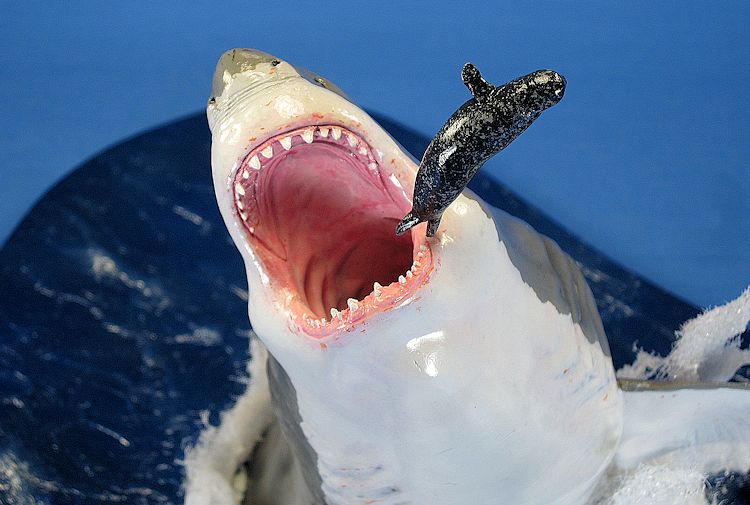
Pegasus Hobbies 1/18 Great White Shark
| KIT #: | 9501 |
| PRICE: |
|
| DECALS: | N/A |
| REVIEWER: | Scott Lyle |
| NOTES: |
|

| HISTORY |
“Off the
Coast of Chatham”
A diorama featuring Pegasus’ Great
White Shark
The Grey Seal is a large species of seal that can
reach a weight of well over 800 pounds.
It is commonly
found in the northern areas of both sides of the Atlantic Ocean.
Aggressively hunted during the last century, its numbers
had waned to the point that it was virtually extinct in New England except for a
few small colonies that existed in Maine.
In 1972 Congress passed the Marine Mammal Protection Act
which granted federal protection status to the seals, and since then their
numbers have rebounded strongly.
The town of Chatham, Massachusetts, a popular summer
destination on the “elbow” of Cape Cod, has seen a
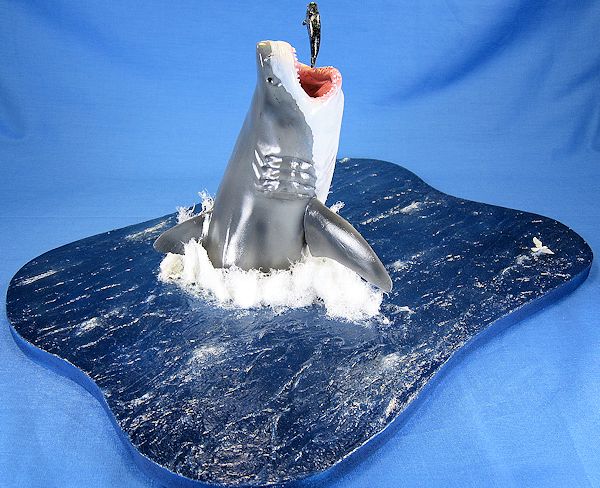 dramatic
increase in the number of seals that make its sandy coastal areas their home.
But the increase in the number of seals has also brought
about an increase in the number of their main predator - the Great White Shark
(cue scary shark music…).
dramatic
increase in the number of seals that make its sandy coastal areas their home.
But the increase in the number of seals has also brought
about an increase in the number of their main predator - the Great White Shark
(cue scary shark music…).
Here in the Boston area reports of
White Shark sightings off of Chatham have become so routine lately that we take
it for granted, but it is a fairly new phenomenon.
It is only in the last ten years or so that the Whites
off of Chatham have garnered significant media attention.
But if the Cape hasn’t always been a White Shark hot
spot like the Great Barrier Reef or the tip of South Africa, you’d never know
it.
An active shark tracking unit, the Cape Cod Shark Hunters (see their
excellent website for more information) now track the sharks using aircraft and
boats, and avid watchers of the Discovery Channel’s “Shark Week” might be
familiar with shows like “Return of Jaws” and “Jaws Comes Home”.
With thousands of seals now a permanent part of the
Cape’s landscape, the sharks are here to stay.
In terms of interactions between
people and the Cape’s sharks, researchers are quick to point out there hasn’t
been a fatal shark attack in Massachusetts waters since 1936.
The summer of 2012 saw a well-publicized attack on a man
in the waters north of Chatham however (he survived with damage to both legs,
not to mention he probably filled his trunks), and logic would suggest that as
shark populations continue to rise, one day the inevitable will happen.
One thing that might help prevent us New Englanders from
routinely becoming shark food; cold Cape water!
While there are many brave souls who surf, boogie board,
and swim, cool water temperatures here in the northeast generally keeps the
masses safely on land reading and planning their next trip to the ice cream
stand.
That Florida, Hawaii, and California lead the country in shark attacks
may have more to do with numbers of people in the water than anything else.
The White Shark is a truly amazing
animal.
It is the largest meat-eating fish in the world; routinely reaching
sizes over 16 feet in length and 1 ton in weight.
To attain that size it feeds on large fish, small
whales, dolphins, and of course, seals.
In recent years researchers studying Whites off of South
Africa have discovered that the sharks often leap completely out of the water
when pursuing their prey.
Numerous documentaries have been made (the “Air Jaws”
series being the main one) showing these huge sharks rocketing up from the
bottom to attack a seal that is swimming on the surface.
The images of such
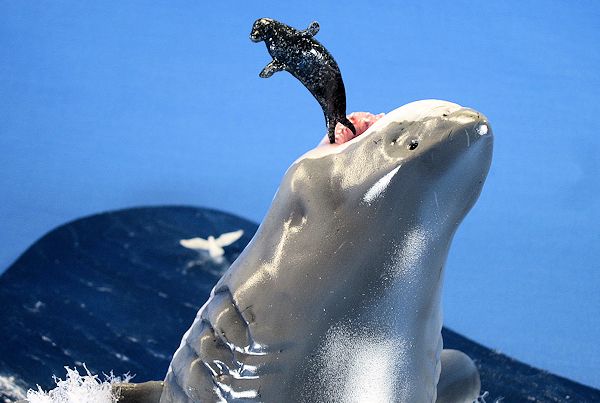 attacks
are dramatic and unforgettable, with the seal often clenched in the massive
shark’s jaws in mid-air, or in the case of a near miss, cartwheeling violently
through the air.
Often when the shark misses the seal the hunt continues with the
shark trying to track down the seal and the seal frantically trying to get away.
The seal can often win out, ironically by staying close
to the shark and using its greater maneuverability and tighter turning ability
to evade those deadly jaws until the shark tires out.
attacks
are dramatic and unforgettable, with the seal often clenched in the massive
shark’s jaws in mid-air, or in the case of a near miss, cartwheeling violently
through the air.
Often when the shark misses the seal the hunt continues with the
shark trying to track down the seal and the seal frantically trying to get away.
The seal can often win out, ironically by staying close
to the shark and using its greater maneuverability and tighter turning ability
to evade those deadly jaws until the shark tires out.
Pegasus announced their intention
to bring out a scale model of a Great White Shark over a year ago, and it
finally hit store shelves this spring.
When I heard about it I thought about constructing a
diorama showing the shark breaching the water with a small seal flying through
the air just inches from the shark’s jaws.
The only problem was I didn’t have a model seal to
accompany the model shark.
I then discovered Mantis Miniatures, a company from
Poland that makes a line of high quality resin armor and wildlife figures.
In one of their wildlife sets they produce a small resin
seal, the size of which is perfect to be a seal “pup” (or lunch…) in my diorama.
Perusing some online images of Great Whites leaping, I soon picked one out that would act as the inspiration for my scene. In the shot the shark has just burst from the water’s surface and is about 2/3rds out of the water, its jaws wide open and twisting as it tries to seize its prey. With a printout of that picture in hand, I was ready to begin.
| THE KIT |
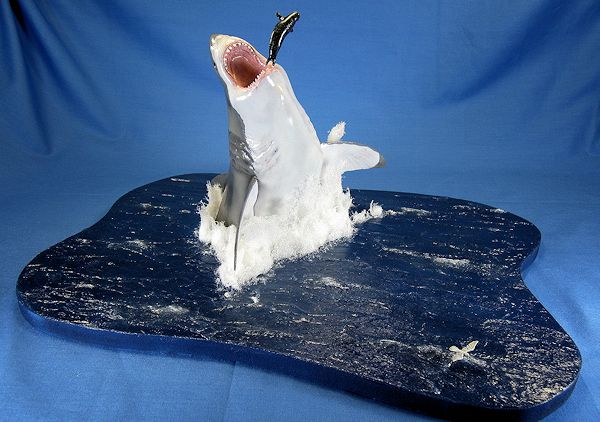 The Pegasus
Great White Shark is a combination injected-molded plastic and vinyl model kit.
The shark itself is made of vinyl, and it’s big and
heavy.
Like many vinyl kits the parts count is low; this one has just the
shark’s body, dorsal fin, tail, pectoral fins, and then smartly, two different
heads.
The two heads give you the choice of modeling your shark with its mouth
closed, as if it’s out cruising, or with its mouth wide open, as if it’s out
attacking.
The Pegasus
Great White Shark is a combination injected-molded plastic and vinyl model kit.
The shark itself is made of vinyl, and it’s big and
heavy.
Like many vinyl kits the parts count is low; this one has just the
shark’s body, dorsal fin, tail, pectoral fins, and then smartly, two different
heads.
The two heads give you the choice of modeling your shark with its mouth
closed, as if it’s out cruising, or with its mouth wide open, as if it’s out
attacking.
The kit also includes parts to
make a scuba diver in a large shark cage.
A flat base is also included, as are posts to mount the
finished shark and cage in a diorama setting.
Detail is at a high level – for instance, the shark’s
lower jaw realistically features a couple rows of teeth.
Pegasus has
done a good job capturing the menacing bulk and power of this awesome creature.
| CONSTRUCTION |
The Shark:
Construction started off with the
shark’s head.
Choosing the “attacking” head, I first had to clean up the parts’
seams.
With a vinyl kit you cannot scrape the seams away with your knife (the
vinyl is too soft); you have to trim them away carefully.
Once this was done I glued the lower jaw piece in place
using CA glue (regular styrene glues won’t work on vinyl), and then attacked the
seam with Squadron Green Putty and Mr. Surfacer 500.
After a few passes of both I moved on to the shark’s
body, and here’s where I recorded a “first” for me in my modeling career – using
a miter saw to cut a model part.
Since I was going to be posing the
shark dramatically leaping out of the water, I had to cut its body just behind
the dorsal fin.
To cut through the large vinyl piece, I held it firmly in my
miter saw and let the blade fly.
When the vinyl shards settled I next glued the head
assembly to the body, and then tackled that seam.
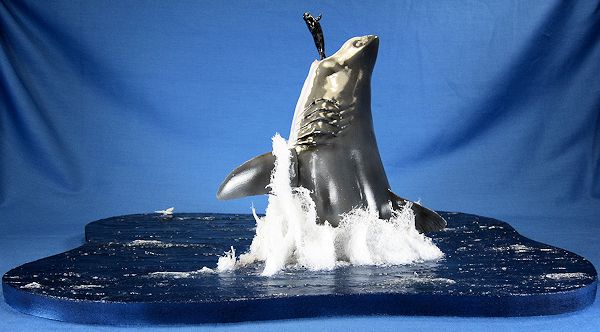 The dorsal and pectoral fins went on next, and a
couple of swipes of Mr. Surfacer 500 were all that was needed to fill the seams.
With that I grabbed my mini-Jaws and headed to the
airbrush booth.
The dorsal and pectoral fins went on next, and a
couple of swipes of Mr. Surfacer 500 were all that was needed to fill the seams.
With that I grabbed my mini-Jaws and headed to the
airbrush booth.
Before spraying the gray of the
shark’s upper body I masked off the white undersides with Silly Putty.
I then airbrushed Testors Dark Gull Gray onto the upper
surfaces, followed by some Testors Gunship Gray on the uppermost surfaces and
dorsal fin for more variation.
In order to make the shark look
more realistic I borrowed some techniques from the armor modeling world.
I added some scratches and “chips” around the animal’s
mouth and snout using a couple different shades of pink and gray, and then mixed
a homemade filter of heavily thinned medium gray and painted it over the entire
model.
I added a reddish wash to the insides of the mouth, and then picked out
the teeth in white.
I painted the eyes black, and with that the shark was
done.
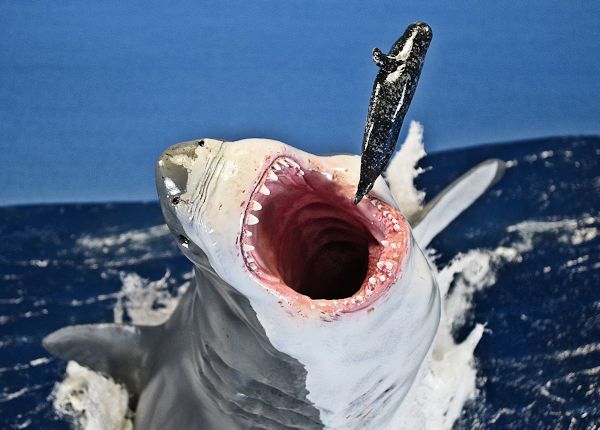 The
Base:
For the diorama’s base I choose to
use a piece of ½” thick MDF that I cut with a jigsaw.
I painted it white with some BIN primer, and then
airbrushed various shades of Tamiya blue onto it.
I then glued the completed shark onto it using Walthers
“Goo”.
The
Base:
For the diorama’s base I choose to
use a piece of ½” thick MDF that I cut with a jigsaw.
I painted it white with some BIN primer, and then
airbrushed various shades of Tamiya blue onto it.
I then glued the completed shark onto it using Walthers
“Goo”.
In order to construct
realistic-looking ocean waves I decided to try sculpting waves out of a material
called Liquitex Gloss Super Heavy Gel Medium.
This is an artist’s material that looks like a white
paste and dries transparent.
Using an old (well it’s old now…) spatula, the “blade”
of which I cut down to about half ts original size, I spread the gel onto my
base, trying to sculpt waves as I went.
The process reminded me very much of icing a cake.
Letting the medium dry overnight, I added more “waves”
the next night, a process I repeated a few times to make the ocean’s surface
more three dimensional and less flat.
At this point I arrived at what I
knew was going to be the chief challenge of this project - modeling realistic
splashing effects around the shark.
Having never done anything like that before, I went
online for ideas and eventually found an article in Tamiya Model Magazine #123
entitled “Splash Down” by Stefan Bernet.
The article details how the author created neat
splashing effects in a landing craft diorama using pieces of the white abrasive
part of kitchen sponges and gel medium.
Procuring some white kitchen sponges, I removed said
white scrubby surfaces and tore them up into randomly shaped pieces.
I then glued them around the shark using white glue and
once that was dry, I coated them on both sides with the gel medium.
At this point they still looked too flat, so I glued
tufts of torn up cotton balls here and there around the bases of the sponge
pieces to try to “fill out” the various splashes.
Painting the gel medium on the cotton ball pieces caused
the cotton to flatten out a bit, so I glued smaller sponge pieces onto them.
It took a few nights of attaching the pieces and coating
them with medium before I was satisfied with the look of it all, though it seems
like it’s one of those endeavors where you could spend forever working on it and
still not be completely happy with the result.
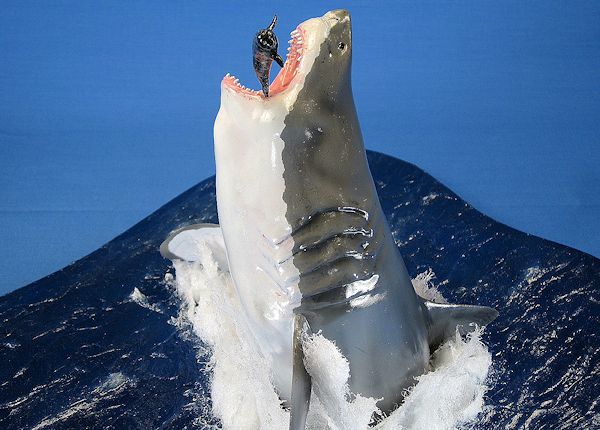 Painting
the Seal:
The Mantis seal came in a “holding
its head up” position and I needed him to be in more of a “Holy Crap a giant
shark is trying to eat me” position, so I chopped off his head and lowered it,
filling the resulting seam with putty.
I then painted him Vallejo Black Gray, and then added
his gray spots using the damp sponge technique and some Testors Dark Gull Gray.
To pose him on the edge of the shark’s mouth I knew he
would need to be pinned, so I trimmed a piece off of a sewing needle and
carefully drilled a hole in the shark and another one in the seal’s tail
flipper.
The pin worked nicely.
Painting
the Seal:
The Mantis seal came in a “holding
its head up” position and I needed him to be in more of a “Holy Crap a giant
shark is trying to eat me” position, so I chopped off his head and lowered it,
filling the resulting seam with putty.
I then painted him Vallejo Black Gray, and then added
his gray spots using the damp sponge technique and some Testors Dark Gull Gray.
To pose him on the edge of the shark’s mouth I knew he
would need to be pinned, so I trimmed a piece off of a sewing needle and
carefully drilled a hole in the shark and another one in the seal’s tail
flipper.
The pin worked nicely.
The same Mantis set that supplied
the seal also supplied the sea gull (it’s a “Coastal Creatures” sort of set),
and the final step was to give everything a good coat of Future to add a glossy,
watery sheen.
With that, my Air Jaws diorama was complete.
| CONCLUSIONS |
| REFERENCES |
-
Tamiya Model Magazine International #123,
“Splash Down”, Stefan Bernet
-
Wikipedia,
the Online Encyclopedia
October 2013
If you would like your product reviewed fairly and fairly quickly, please contact the editor or see other details in the Note to Contributors.